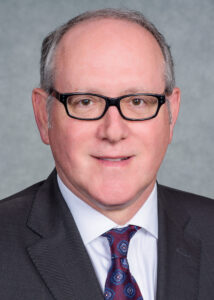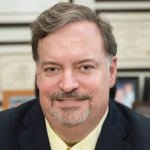Kenneth G. Saag, MD, MSc, is bringing a penchant for problem solving, a forward-thinking approach and a high level of optimism to his new role as 85th president of the ACR.

Dr. Saag
Dr. Saag received his Doctor of Medicine from Northwestern University, Evanston, Ill., and his Master of Science in epidemiology from the University of Iowa, Iowa City.
He is a professor of medicine and holds the Jane Knight Lowe endowed chair in the Division and the Department of Medicine at the University of Alabama at Birmingham (UAB). He became division director of clinical immunology and rheumatology in July 2020. He is also the director of the UAB Comprehensive Arthritis, Musculoskeletal, Bone, and Autoimmunity Center. He has been a practicing physician with UAB Medicine and a researcher in the UAB School of Medicine since 1998. Dr. Saag’s research focuses on the comparative effectiveness and safety of therapeutics, as well as methods to improve the quality of care in gout and osteoporosis.
In addition to his considerable work with the ACR over the years, he also served as president of the National Osteoporosis Foundation Board of Trustees and remains the only rheumatologist to have held that position.
As Dr. Saag prepared to begin his term as ACR president, he shared his thoughts about capitalizing on the organization’s many strengths, facing challenges head-on and positioning the College for a strong future.
The Rheumatologist (TR): You have followed a rather unusual path to your current positions in rheumatology, including a start as an engineer. How would you describe your early journey, and how has it shaped your career?
Dr. Saag: I grew up in Evanston, a community that was diverse and multicultural, and I worked blue-collar jobs in high school, both experiences that gave me important perspectives on the world that might be different from those of other people. I ended up earning a Bachelor of Science in engineering from the University of Michigan, which is also very different from a lot of people in medicine. That experience gave me a quantitative, analytical approach to problem solving, one that has served me well in the kind of research that I do now and also in the way I think about problems of all kinds.
Another thing that has been helpful in my background came during my residency and year as chief resident. I trained at a program in a university-affiliated community hospital and really got to see a premier demonstration of private practice with some academic overtones. One of the things this helped me realize is that, although most of my career has been focused on academic medicine, there are really wonderful opportunities in private practice.
At the ACR, I look forward to working across the aisle, so to speak, so that symbiosis of the two continues to occur within the organization.
TR: Why did you finally decide to put your focus on rheumatology?
Dr. Saag: I was already interested in the musculoskeletal system through a previous interest in orthopedics, physical medicine and rehabilitation, but I got interested in rheumatology, as many people do, through a really good mentor during my residency. That was Joseph Golbus, MD, who had just finished his rheumatology fellowship and was the person people called when they needed an opinion about a difficult patient. That gave me an appreciation for—and fascination with—a discipline where there were complicated problems, a lot of unknowns and really interesting pathophysiology. I also liked rheumatology because of the continuity and relationships with patients over the long term.
During my fellowship, my interest was strengthened at the University of Iowa—again by really great mentors and role models, such as John Cowdery, MD, Stan Naides, MD, and Bob Ashman, MD.
Interestingly, although, my division was very much about clinical care and fundamental science, I was really the only clinical investigator, so I was pretty much on my own. On the positive side, that forced me to seek out scientists outside the division, including people in public health and general medicine, such as Elizabeth Chrischilles, PhD, Bob Wallace, MD, Dick Wenzel, MD, and Brad Doebbeling, MD, to mentor me in my research development. It was not only a lot of fun to work with them, but it strengthened my interest in academics and also forced me to see the advantages of working in an interdisciplinary way.
That has been useful in the ACR in terms of building bridges between people who may think about things in dissimilar ways, so we can collectively make a bigger difference.
In 1998, a great opportunity came along. Robert Kimberly, MD, and Bill Koopman, MD, strongly encouraged me to become a practicing physician with UAB Medicine and a faculty researcher in the UAB School of Medicine, and I have been at UAB ever since. UAB has been a great academic home, and despite our Midwestern roots, my wife and family have very much enjoyed our 23 years in Birmingham.
TR: You have served as a member and chair of the ACR Committee on Quality of Care and as chair of the Committee on Corporate Relations. What drove you to begin volunteering with the ACR?
Dr. Saag: I’m a social person, I enjoy interacting with my patients and my colleagues, and I like teamwork, joining together to solve problems and thinking about strategic challenges. That combination is part of what drove me to the ACR.
Plus, rheumatologists are a fun, exceptionally smart group of people who have a lot of energy, so they were a nice group of people to be with. In addition, I have to say that the ACR has probably got about the best staff of any organization I’ve ever worked with. They’re just remarkably dedicated and incredibly accomplished, so that also made it fun and easy to be a volunteer.
TR: What was some of your work on those committees?
Dr. Saag: On the Committee on Quality of Care, we took a systematic and rigorous approach to developing guidelines and how we address conflicts. We developed a white paper on quality measures, and we thought about how we, as the ACR, should position ourselves nationally as a premier organization.
During my more recent work on the Committee on Corporate Relations, our focus was on rethinking our relationship with the private sector at a time when our meetings had gone virtual due to the pandemic: How do we maintain the intellectual freedom of the organization and avoid perceptions of conflict? That’s been an interesting topic as well.
TR: As you start your term as president, what work would you like to see the ACR continue or begin in the coming year?
Dr. Saag: One of the things that’s really important to me is fostering the ACR’s relationship with our colleagues in all of the different international rheumatology organizations, including the global “LARs,” as we call them: European Alliance of Associations for Rheumatology (EULAR), Pan American League of Associations for Rheumatology (PANLAR), Asia Pacific League of Associations for Rheumatology (APLAR) and African League Against Rheumatism (AFLAR). We’re part of a global community, so the more we can embrace the ability to address some of these diseases and the challenges we face as professionals in dealing with these problems internationally, the better.
Another has got to be the workforce. There have never been more people interested in becoming rheumatologists than there are now, and yet we don’t have enough slots for all of them. At the same time, we know that major portions of the country are undersupplied by rheumatologists. At my university, we have a six- to nine-month wait to get in to see a rheumatologist. That’s a problem. Related to that are issues of diversity, equity and inclusion. We have a new subcommittee looking into a lot of great ideas to begin addressing the undersupply of diverse participants in the rheumatology workforce and in our training programs.
In addition, we’re working on increasing diversity within the volunteer leadership of the ACR in terms of race/ethnicity, sex/gender and different practice communities, including getting more practitioners, clinicians and members of the full interprofessional team from outside of the academic sector to be part of the ACR leadership.
TR: What do you see as crucial for the future of the ACR?
Dr. Saag: Diversifying the ACR’s revenue streams is more critical than ever. We anticipate that, as we move forward and offer both in-person and virtual educational opportunities, it will be necessary to modify our business models to meet our learners’ expectations. That means we need to think about doing other things to support the organization, such as possible new financial models for the ACR’s qualified clinical data registry (RISE) that would provide additional value for the people who are contributing the data, and benefit our organization as a whole.
Another big challenge going forward is growing academic research and investigation in rheumatology. We need to maintain strong research within our field and continue to advance science in areas such as precision medicine, informatics in clinical care and outcomes research.
We also should be thinking about how we can be a little bit more like the oncologists in doing consortia research. Rheumatology encompasses a lot of very rare diseases, so we need to—in a more facile way—be able to turn a clinical encounter into a research encounter, so patients get enrolled in collaborative clinical trials that, optimally, are supported by the federal government or another entity that doesn’t have a financial stake in the outcome of the research.
TR: What do you see as some of the biggest obstacles for rheumatologists in the coming year, or even in the long term, and what are the paths forward?
Dr. Saag: The biggest immediate question is: How do we get back together? Rheumatologists are a very social group, and a lot of what the ACR does is bring people together in person at both the volunteer leadership level and at the annual meeting. We need to start figuring out how to get back together and have more in-person ways to share knowledge. It may be that we shift our model a little bit, so instead of having just a huge annual meeting be the centerpiece, we might consider returning to more regional meetings, which were very popular for many, many years. That’s something we’re going to be figuring out over the next few years, hopefully sooner rather than later.
Beyond that, we need to think about how we in the profession can focus our efforts on what we do best. For the ACR, that involves advocacy on important policy issues, including how the ACR can help reform some of the burdens and barriers to care. There are barriers in our academic centers, too, and one is the increasing overhead costs of doing research and fellowship training. In both cases, we have to streamline our processes so we can really devote our energies to the right things and not get burned out.
TR: What else would you like to share about yourself that might be interesting for ACR/ARP members?
Dr. Saag: I am an optimist. I’m an optimist about political divisions—both in the country and in other organizations—and I think we can come together more around many things we agree upon. I’m optimistic when we write research grants, even those that are really long shots. I’m optimistic that we can return to normalcy after COVID-19. Overall, I’m the kind of person who hangs in there until the very end and believes the outcome is generally going to be good.
I’ll be bringing that optimism with me to my new position as ACR president and will work very hard for the organization to do everything I can to try to achieve the very best outcomes.
Leslie Mertz, PhD, is a freelance science journalist based in northern Michigan.

